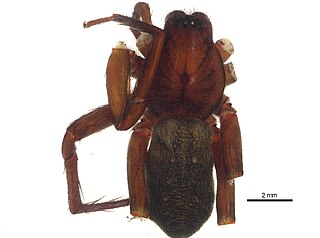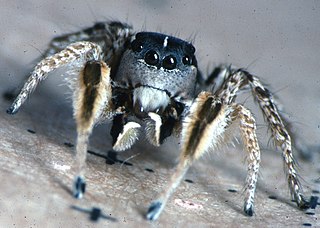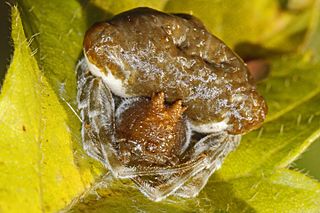
The Araneomorphae are an infraorder of spiders. They are distinguishable by chelicerae (fangs) that point diagonally forward and cross in a pinching action, in contrast to the Mygalomorphae, where they point straight down. Araneomorphs comprise the vast majority of living spiders.

The Pholcidae are a family of araneomorph spiders. The family contains over 1,800 individual species of pholcids, including those commonly known as cellar spider, daddy long-legs spider, carpenter spider, daddy long-legger, vibrating spider, gyrating spider, long daddy, and skull spider. The family, first described by Carl Ludwig Koch in 1850, is divided into 94 genera.

Dictynidae is a family of cribellate, hackled band-producing spiders first described by Octavius Pickard-Cambridge in 1871. Most build irregular webs on or near the ground, creating a tangle of silken fibers among several branches or stems of one plant.

Nigma is a genus of cribellate araneomorph spiders in the family Dictynidae, and was first described by Pekka T. Lehtinen in 1967. They have a wide distribution, including Eurasia, North America, and Northern Africa. N. walckenaeri is one of the biggest members of the Dictynidae, growing up to 5 millimetres (0.20 in) long. They are translucent green and sometimes have red or black markings on the abdomen.

Nigma walckenaeri is a green cribellate spider up to five millimetres long, the largest of the family Dictynidae. While most of the body is a somewhat yellowish, the abdomen is a shining green, which makes it rather distinct and hard to confuse with other species. The green color makes it almost invisible. Males have an elevated head region. From August to October these spiders can be found in gardens or on walls - often on big leaves such as lilac or feral grapevine. The spider catches insects, sometimes larger than itself, in its web, which it builds on the surface of leaves. The female hides the 7-millimetre long egg sac on a place distant from its retreat.

Nigma puella is a species of spider belonging to the family Dictynidae. It is found in Europe, Azores, Madeira, Canary Islands and parts of North Africa.
Nigma hortensis is a spider species found in Portugal, Spain, France and Algeria.

Alireza Zamani is an Iranian arachnologist and taxonomist.

Anachemmis is a genus of North American false wolf spiders that was first described by Ralph Vary Chamberlin in 1919. It was briefly synonymized with Titiotus, but was reconfirmed as its own distinct genus in 1999.
Lepidanthrax linsdalei is a species of bee flies in the family Bombyliidae.

Habronattus tarsalis is a species of jumping spider in the family Salticidae. It is found in the United States and has been introduced into Hawaii.

Habronattus conjunctus is a species of jumping spider in the family Salticidae. It is found in the United States and Mexico.
Diguetia albolineata is a species of desertshrub spider in the family Diguetidae. It is found in the United States and Mexico.

Acanthepeira stellata, known generally as the starbellied orbweaver or starbellied spider, is a species of orb weaver in the spider family Araneidae. It is found in a range from Canada to Mexico. It is most commonly found along the Eastern and Western coastline of North America.
Herpyllus cockerelli is a species of ground spider in the family Gnaphosidae. It is found in the United States and Mexico.

Philodromus marxi, the metallic crab spider, is a species of running crab spider in the family Philodromidae. It is found in the United States. They are a sexually dimorphic species. The males are smooth with a metallic sheen and the females present as bristly white and grey.

Mastophora phrynosoma is a species of orb weaver in the spider family Araneidae. It is found in the United States. Like all known species of the genus Mastophora, adult females are bolas spiders, capturing their prey with one or more sticky drops at the end of a single line of silk rather than in a web. Males and juvenile females capture their prey directly with their legs.

Scytodes fusca, the brown spitting spider, is a species of spitting spider in the family Scytodidae. It is found in Central and Southern America, has been introduced into Europe, tropical Africa, Seychelles, Myanmar, China, Japan, and Hawaii.
Phidippus comatus is a species of jumping spider in the family Salticidae. It is found in North America.

Anachemmis linsdalei is a species of false wolf spiders & wandering spiders in the family Zoropsidae. It is found in the United States and Mexico.













